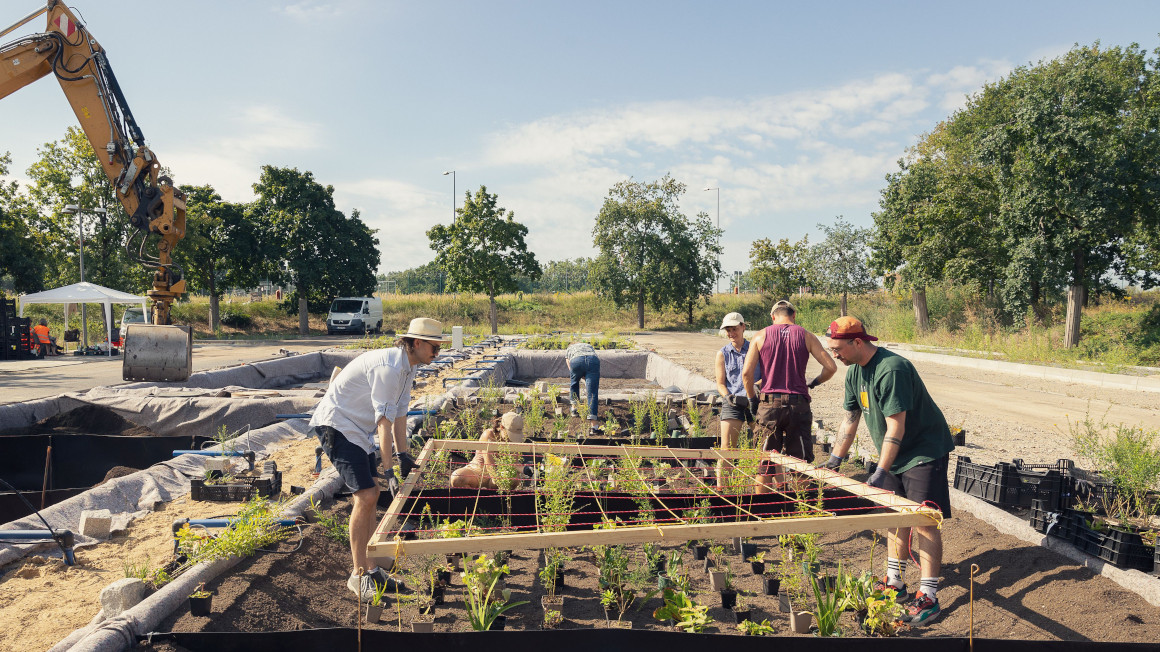Building sponge cities with plant islands
On the former site of Tegel Airport, researchers are testing which plant mix is best suited for so-called evaporation beds and thus for the realisation of sponge cities.

Where streets and houses dominate instead of green spaces and water, it can sometimes become unbearably hot in summer. Solutions are needed because researchers are predicting an increase in heat waves as a result of climate change. Sponge cities can provide effective heat protection. Researchers at the Technische Universität (TU) Berlin want to design such a sponge city neighbourhood on the former site of Tegel Airport. In August, work began on planting a total of six so-called evaporation beds.
Evaporation beds store rainwater
Evaporation beds are an essential cornerstone of water management in a sponge city. The principle: rainwater should no longer run off. Instead, the soil should soak up the water like a sponge and store it so that it can flow into trees, meadows and other green spaces. By creating infiltration and evaporation areas such as flower beds and troughs, the rainwater is kept in the natural cycle and does not flow into the sewage system as is usually the case.
Experimental plant with native and non-native plants
However, this requires suitable climate-resilient plants that can cope with heat, drought and heavy rainfall. Various native and non-native perennials, grasses and small shrubs are therefore being tested at the trial site on the former airport grounds in Berlin-Tegel. They are intended not only to cool the immediate ambient air on hot days, but also to promote biodiversity in the city.
‘I mainly looked at the vegetation in ditches along meadows and pastures as well as the moor grass meadows and searched for plants that occur in well-watered, nutrient-rich locations and, in the case of the moor grass meadows, in rather alternately dry and poor locations. The tall perennials of the ditch vegetation in particular develop a lot of leaf mass and therefore potentially evaporate a lot of water,’ explains Leonard Heß, research assistant in the TU's Vegetation Technology and Plant Utilisation department and head of the project.
The tall pipe grass, shaggy silverbell, Balkan spurge, tall and small meadowsweet, spotted watercress, three-master flower and dyer's broom were planted. Three evaporation beds were planted with species that require a moist and nutrient-rich environment, while the other three were planted with plants that prefer a dry location.
Plant cultivation tested on different soils
In addition to selecting suitable plants for the Schwammstadt quarter, 13 metre long and 4.5 metre wide troughs were created and each covered with a pond liner so that the water does not seep into the ground and the plants can evaporate as much water as possible. A drainage layer on the troughs also protects the plant roots from waterlogging. At the same time, the cultivation of the various plants is not only being tested on conventional soils, but also on areas enriched with biochar. ‘This allows it to store more water, and the plants have access to water for longer during dry periods,’ explains Heß. Finally, the soil was covered with a layer of mineral mulch to prevent unwanted plants from establishing themselves in the beds.
The project is now investigating which vegetation mixtures in the respective evaporation beds on the different soils cope best with the urban environment.
Blueprint for planning future sponge city neighbourhoods in Berlin
The aim of the project is for the Tegel sponge city concept to serve as a blueprint for other Berlin boroughs when planning, building and converting future climate-resilient neighbourhoods. ‘There is no role model for such a test centre in Germany. It's a first,’ says Norbert Kühn, Head of the Department of Vegetation Technology and Plant Utilisation at TU Berlin.
The interdisciplinary research project ‘Optimising the vegetation of evaporation beds and their water balances’ involves TU Berlin, Tegel Projekt GmbH, the Berlin University of Applied Sciences and Berliner Wasserbetriebe. The project, which will run until the end of 2027, is funded by the German Federal Environmental Foundation (DBU).
bb


